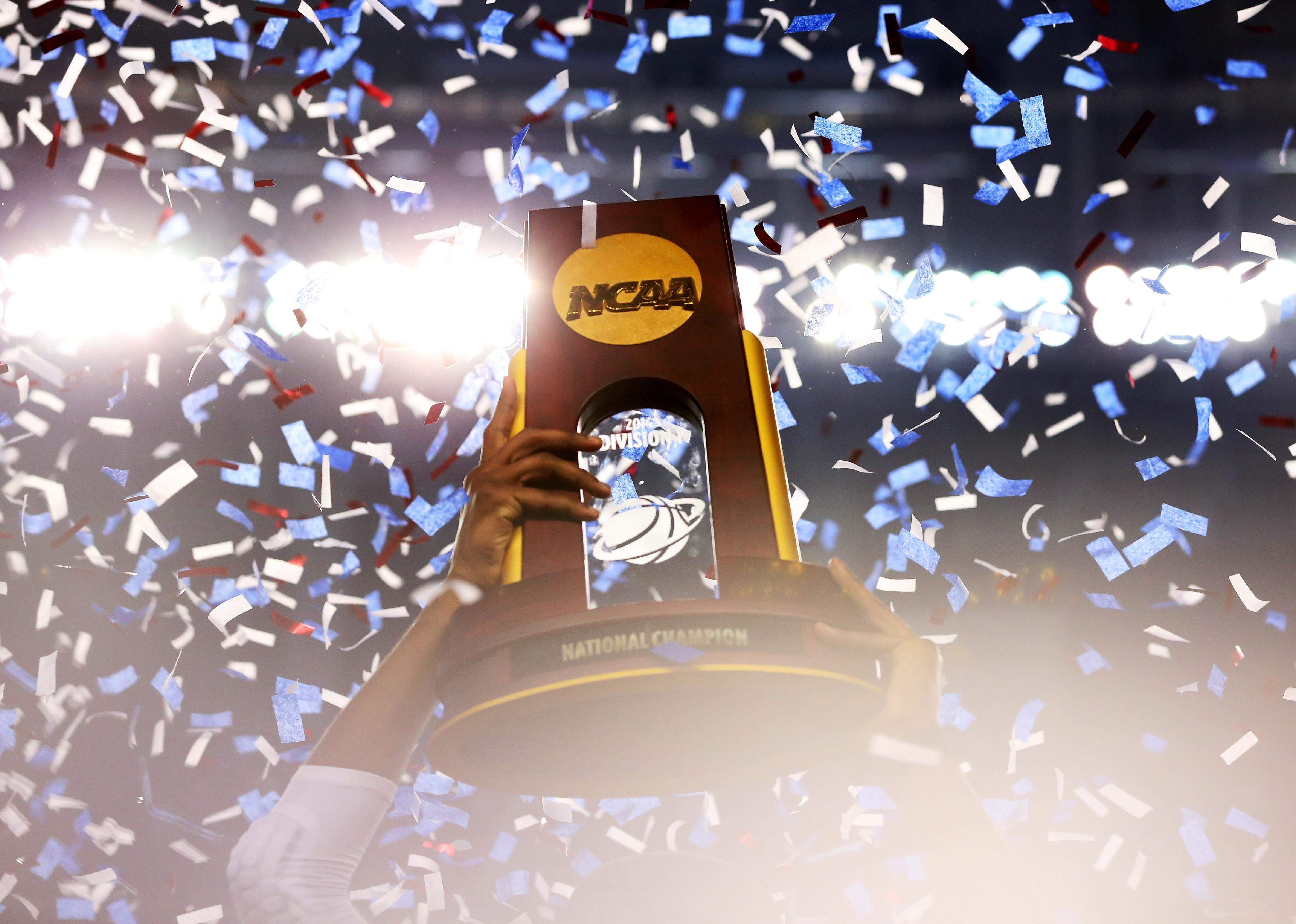
This story originally appeared on BestOdds and was produced and distributed in partnership with Stacker Studio.
10 of the biggest underdog victories in March Madness history
Everyone loves an underdog. Whether it’s an intrinsic desire to root for the little guy or a hedge against laying the favorite, sports fans can’t help but crave the come-out-of-nowhere victory. This propensity is strongest during March Madness, that annual springtime tourney that pits NCAA Division I college basketball teams against one another in a drive toward the national championship.
What we have come to know as March Madness began in 1939, when it featured just eight teams. By 1951, that number doubled to 16. It doubled again in 1975, and yet again in 1985, before finally settling on the 68 first-round contenders we now see each year. According to the Sporting News, the first mention of the moniker “March Madness” was in the Illinois High School Athlete magazine, where high school official Henry V. Porter opined, “A little March madness may complement and contribute to sanity and help keep society on an even keel.”
The term’s association with the NCAA can be traced to the 1982 tournament, when CBS announcer Brent Musburger claimed he purloined the term from local car dealer commercials that aired during his time broadcasting Illinois state high school games (which also led to a lawsuit that resulted in the eventual trademark of the term itself).
One aspect of March Madness that’s open to less debate is that the annual sporting event is a standout with its high possibilities of having an unknown or undervalued team coming out of nowhere to score a major upset.
Leveraging AP Men’s Basketball polls from 1950–2021, BestOdds has come up with a list of some of the greatest and most unexpected underdog wins in the history of the NCAA championship tournament. AP polls are determined by a nationwide panel of sports writers and broadcasters who vote weekly, in a simple points system, to decide the AP Top 25. A team receives 25 points for each first place vote, 24 for second place and so on through to the 25th team, which receives one point. The rankings are set by listing the teams’ point totals from highest to lowest.
Here, teams were ranked by their standing in the polls going into March Madness, with teams that had poorer standings ranking higher on the list. (Lower numbers in the poll indicate a better expected performance, with 1 being the top pick, so a higher number indicates a poorer standing, and thus an underdog victory.) Ties were broken by the team’s preseason standing in the polls. The preseason favorite for that year is also included. From 1949–1960 and 1969–1989, the poll included 20 teams, from 1961–1968 the poll included 10 teams, and from 1990–present the poll has 25 teams.
So without further ado, here are 10 of the biggest underdog victories in NCAA March Madness history.
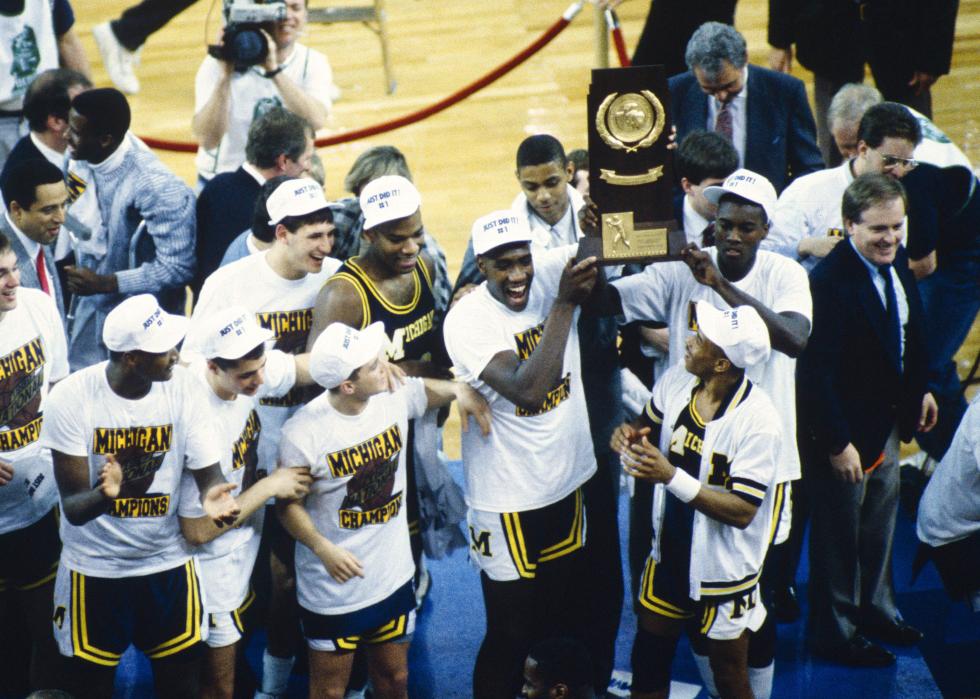
#10. The 1989 Michigan Wolverines
- Final AP poll ranking: 10
- Preseason AP poll ranking: 3
- Preseason AP poll favorite: Duke
The Big Ten is a notoriously tough conference prided on defense. Going into the 1988–1989 season, everyone had their eye on the Wolverines, who were coming off a respectable 26–8 season, but still smarting from a loss to North Carolina in the 1988 Sweet Sixteen. Conference foes Indiana, Illinois, and Iowa all put up winning records, while Purdue, ranked as high as #3, slipped into the rearview. After a 24–7 regular season record (12–6 in the Big Ten Conference), Michigan barreled through the tournament, besting ACC powers North Carolina and Virginia to reach the Final Four.
There, they faced fellow Big Ten member Illinois in a match that few expected the Wolverines to win. But win they did, 83–81, in a nail-biting classic. Two days later, on April 3, Michigan won the title with an 80–79 overtime victory over fellow underdog Seton Hall.
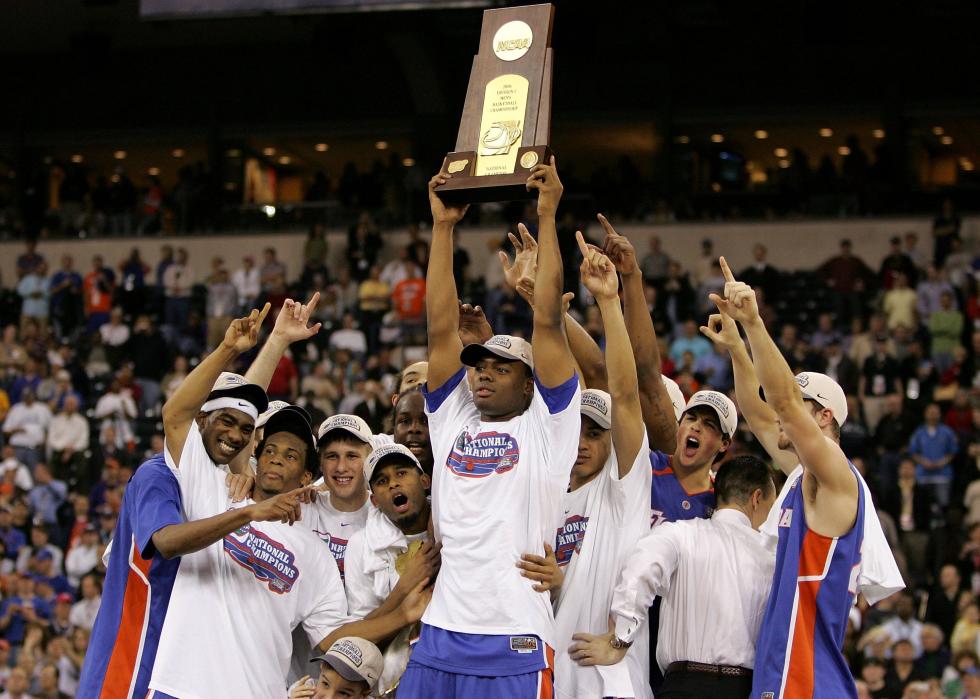
#9. The 2006 Florida Gators (tie)
- Final AP poll ranking: 11
- Preseason AP poll ranking: Unranked
- Preseason AP poll favorite: Duke
Prior to the 2005–2006 season, the Florida Gators had been bounced out in the first round of the tourney each of the past two years. With coach Billy Donovan returning for his 10th season in the Sunshine State and a lineup that featured Joakim Noah, Al Horford, Corey Brewer, and Chris Richard—all of whom would go on play in the NBA—along with team captain Adrian Moss, the Gators took home the SEC Championship against South Carolina after posting a 24–6 regular season record.
Coming into the NCAA tournament ranked 11th in the country, the team beat Big East dynamos Georgetown and Villanova. The Gators then handled upstart George Mason on the way to a 73–57 win over UCLA, who have more NCAA men’s basketball championships than any other school. This would be the beginning of a brief dynasty, as the Gators also won the 2007 championship, becoming the first school to win back-to-back titles since Duke in the early 1990s.
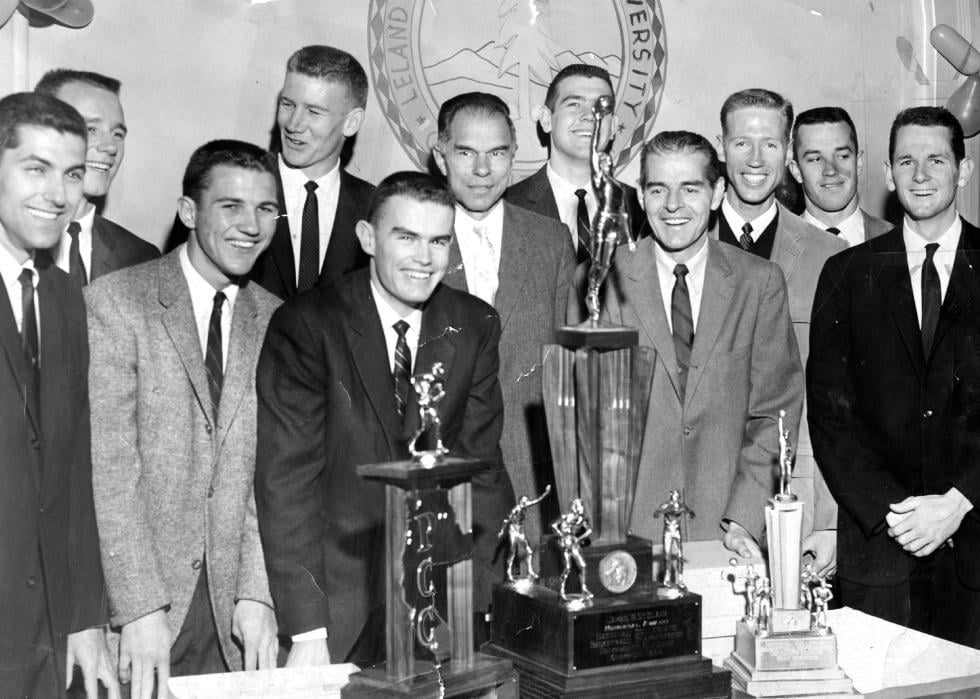
#8. The 1959 California Golden Bears (tie)
- Final AP poll ranking: 11
- Preseason AP poll ranking: Unranked
- Preseason AP poll favorite: Cincinnati
Coming off a modest 19–9 campaign, no one expected much from the Golden Bears heading into the 1958–1959 season. But beginning with a decisive 60–36 win over San Jose State to open the season, the team went on to finish the regular season in impressive fashion, posting a 21–4 record. After wins over Utah and Saint Mary’s, both top 20 teams, Cal made it to the championship game by beating #5 Cincinnati (and its three-time Sporting News Player of the Year Oscar Robertson). The title game was a white-knuckle bout against #10 West Virginia and future NBA Hall of Famer Jerry West, but the Golden Bears squeaked out a 71–70 win.
Just one year later, California center Darrall Imhoff would go on to win gold with the 1960 U.S. Men’s Olympic basketball team—a team coached by the Golden Bears’ own Pete Newell. Imhoff was then drafted third overall in the 1960 NBA Draft by the New York Knicks, right behind Robertson and West.
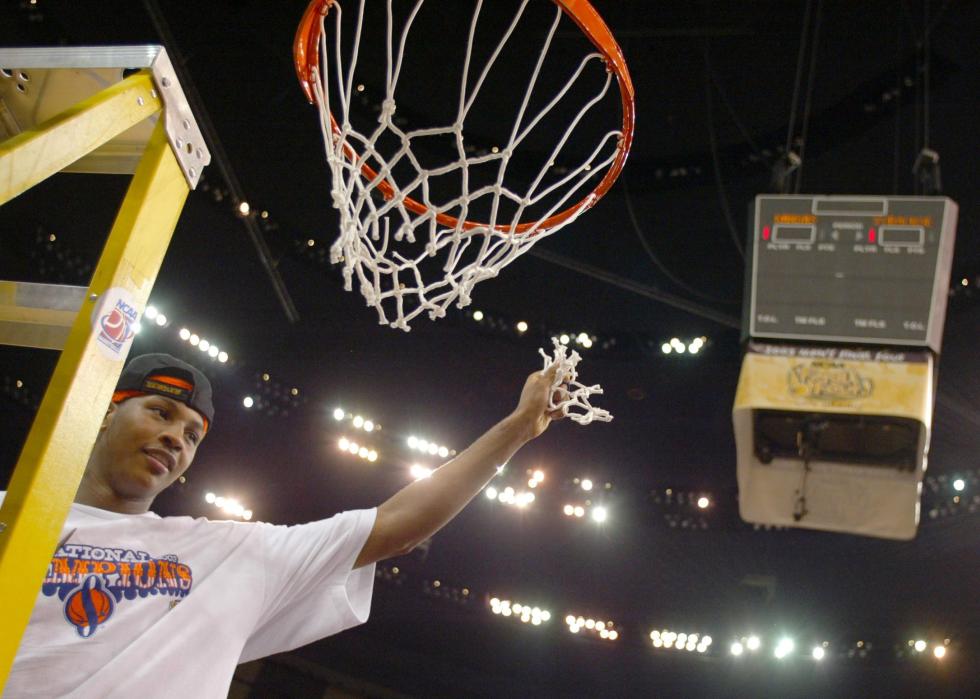
#7. The 2003 Syracuse Orange
- Final AP poll ranking: 13
- Preseason AP poll ranking: Unranked
- Preseason AP poll favorite: Arizona
The 2003 NCAA Championship would be a first title for one of two legendary coaches. On one side was Syracuse’s Jim Boeheim, who in his 27 years as head coach, had taken his team to the Final Four just two times, in 1987 and 1996. On the other sideline was Kansas head coach Roy Williams, who had reached the Final Four four times, finishing as runner up in 1991. The Syracuse Orangemen, as they were known at the time, were led by freshmen Carmelo Anthony and Gerry McNamara. Together, these first-year phenoms blazed a trail through the tournament, culminating with an 81–78 victory over Kansas.
Anthony was named the NCAA Tournament Most Outstanding Player and months later was drafted in the first round by the NBA’s Denver Nuggets. Later, still fond of Syracuse, he donated $3 million to his alma mater to build the Carmelo K. Anthony Basketball Center.
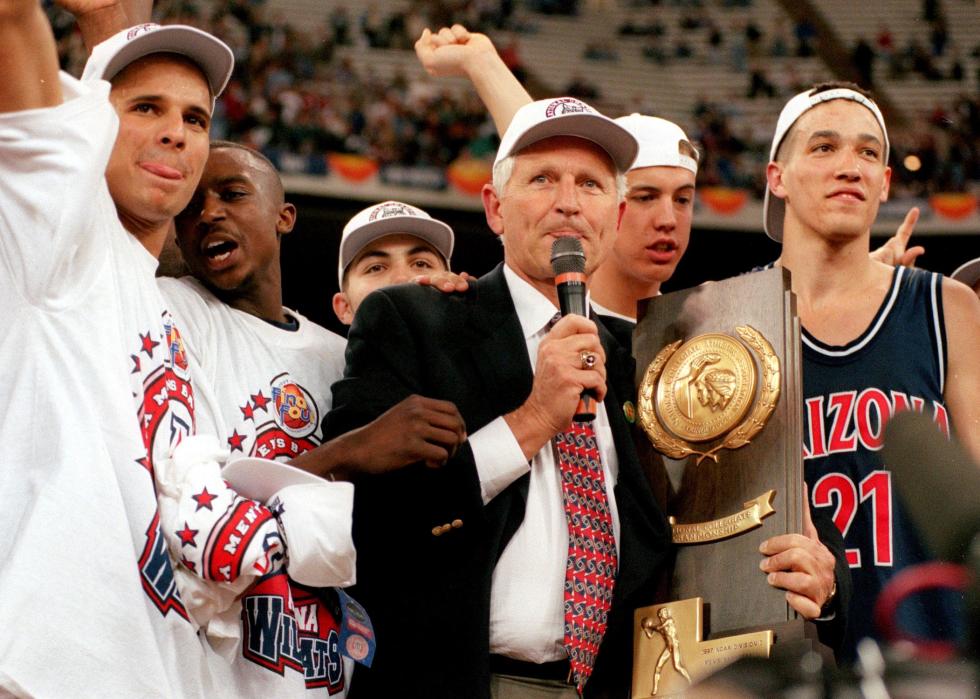
#6. The 1997 Arizona Wildcats
- Final AP poll ranking: 15
- Preseason AP poll ranking: 19
- Preseason AP poll favorite: Cincinnati
There’s a first time for everything, and for the Arizona Wildcats, 1997 marked many firsts in program and college basketball history. Yes, they won their first-ever championship that year, defeating top-ranked Kentucky, 84–79, in overtime, but the team’s true mark on NCAA history was that they were the first school to defeat three top seeds in one tournament. Before their victory over Kentucky, the Wildcats bested top-ranked Kansas and North Carolina.
Fun fact: In the opening game of the season, the Wildcats took down North Carolina 83-72, providing a harbinger of things to come in the Final Four rematch.
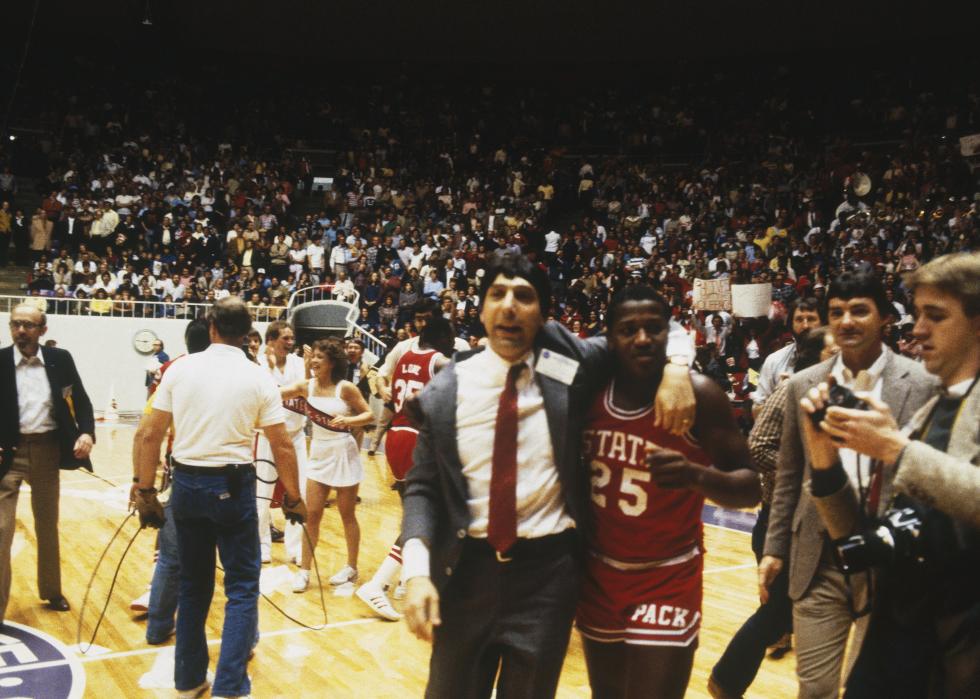
#5. The 1983 NC State Wolfpack
- Final AP poll ranking: 16
- Preseason AP poll ranking: 16
- Preseason AP poll favorite: Virginia
To this day, the story of the 1983 “Cardiac Pack” still evokes awe among sports fans. After putting up a respectable, if not spectacular 17–10 regular season record, the Wolfpack took the ACC Tournament title from Virginia. Led by notorious rabble-rousing coach Jim Valvano, NC State carried that momentum into a matchup with #1 seed Houston in the NCAA title game. But Houston was led by future NBA Hall of Famers Clyde Drexler and Akeem Olajuwon, and the Cougars were heavily favored to win. (The Drexel and Olajuwon duo was known as Phi Slamma Jamma for their high-scoring and dunk-filled style of play.)
This battle of underdogs versus superstars would come down to the last shot. NC State’s Dereck Whittenburg lofted an airball, but center Lorenzo Charles, waiting under the basket, outboxed Olajuwon and tapped it in for the 54–52 victory.
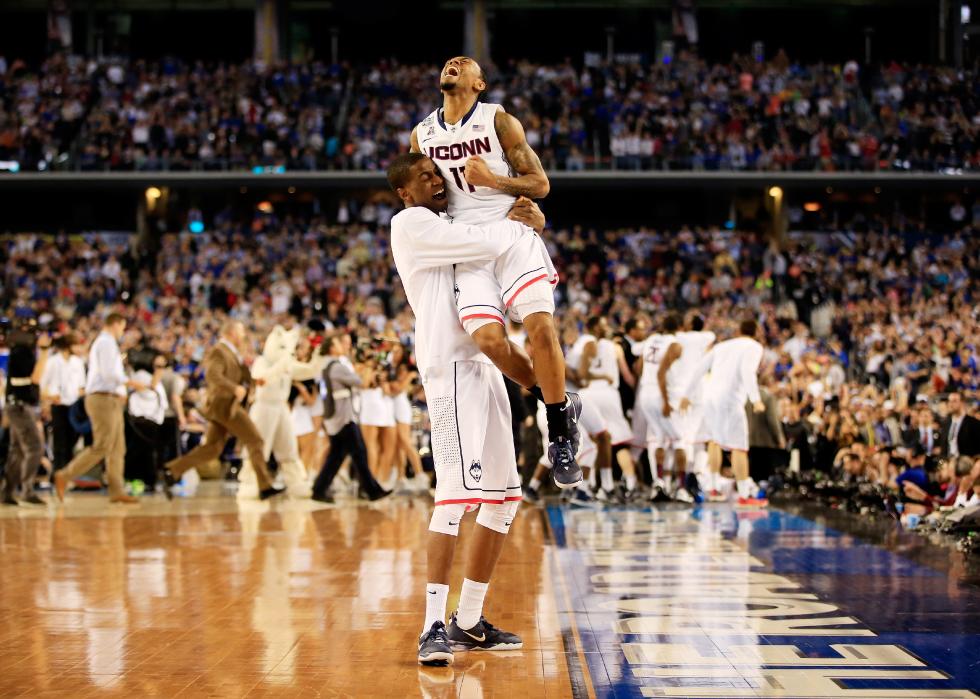
#4. The 2014 UConn Huskies
- Final AP poll ranking: 18
- Preseason AP poll ranking: 18
- Preseason AP poll favorite: Kentucky
The year before their 2014 title, the Huskies had a great season by many standards, going 20–10, but they were banned from participating in tournament play, due to sanctions resulting from years of substandard academic progress ratings among team members. Out for vengeance, second-year coach Kevin Ollie guided UConn to a 24-7 regular season record in 2014.
The team hit a speedbump in the American Athletic Conference final, losing to #5 Louisville, but bounced back in the NCAA tourney with wins over top 10 ranked Villanova and Iowa State. UConn also topped #11 Michigan State, before a stunning decisive win over #1 Florida, 63–53. The Huskies then faced college basketball royalty Kentucky for the title, and pulled out a 60–54 victory.
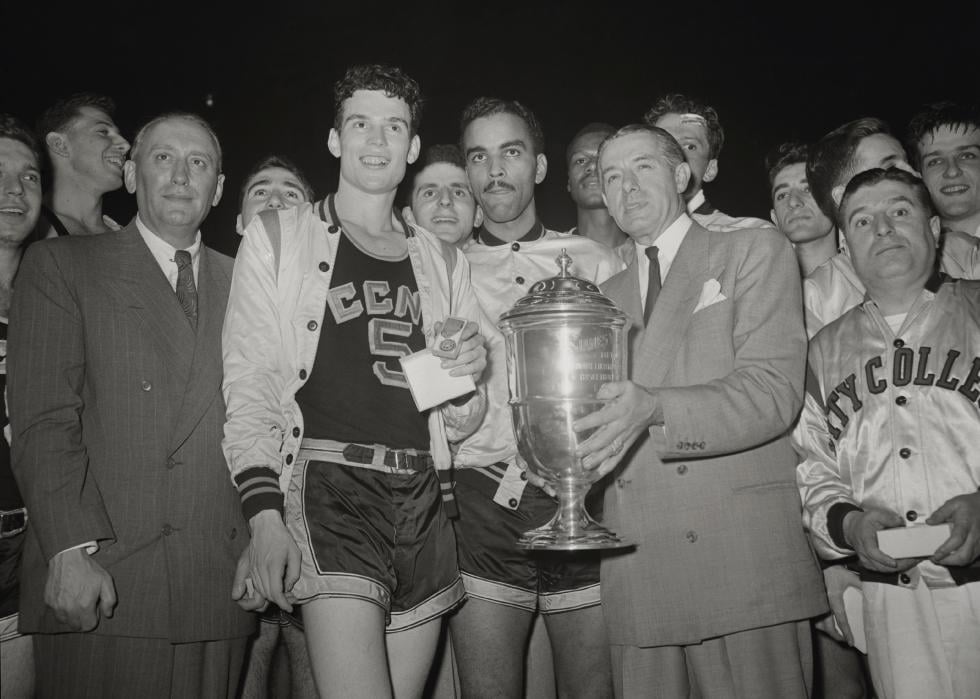
#3. The 1950 CCNY Beavers
- Final AP poll ranking: Unranked
- Preseason AP poll ranking: 14
- Preseason AP poll favorite: St. John's (NY)
The Beavers provided headlines of hoop dreams and scandal during a memorable 1950 season. They were the first NCAA championship team to have Black players in its starting lineup, setting a precedent that redefined the sport. But even after a 17–5 regular season, there was no love for the team by the poll voters. That did not stop them—and maybe even motivated them—to winning the NIT and NCAA titles, both over top-ranked Bradley.
Scandal later engulfed the team when it was revealed that seven players were charged for their involvement in fixing games during the regular season, a fiasco that involved a total of seven schools and supposedly members of organized crime.
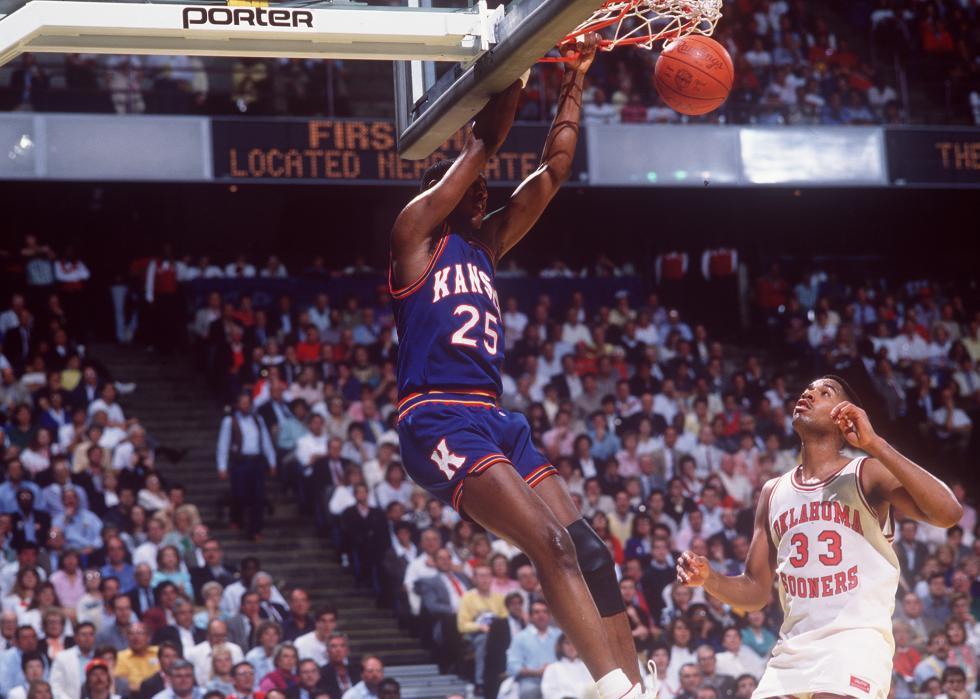
#2. The 1988 Kansas Jayhawks
- Final AP poll ranking: Unranked
- Preseason AP poll ranking: 7
- Preseason AP poll favorite: Syracuse
Jayhawks fans still remember the year of Danny and the Miracles. Led by star player Danny Manning, the 1988 squad got off to a rocky 12–8 start, but turned things around in the season’s second half, winning 15 of its last 18 games, including a win over rival Oklahoma. Manning would go on to be named National Player of the Year, and head coach Larry Brown became the only coach in basketball history to win both an NCAA national championship and an NBA title, the latter of which he accomplished with the Detroit Pistons in 2004.
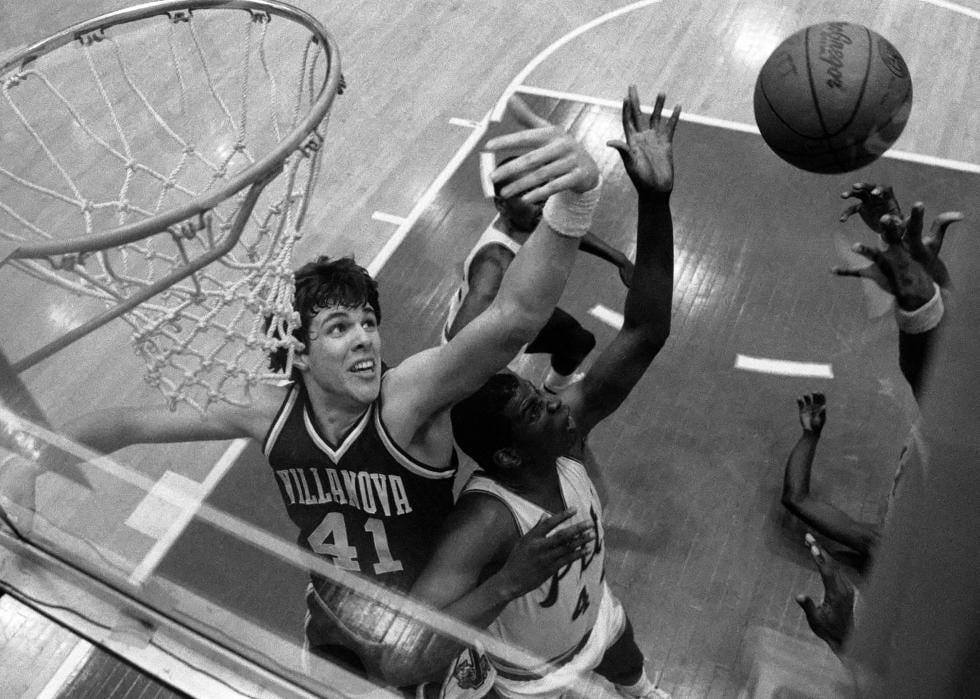
#1. The 1985 Villanova Wildcats
- Final AP poll ranking: Unranked
- Preseason AP poll ranking: Unranked
- Preseason AP poll favorite: Georgetown
For any college hoops fan, this championship team was utterly unforgettable. Dubbed by Sports Illustrated as “The Perfect Game,” the 1985 NCAA title match had all the makings of a David versus Goliath showdown. Defending champion and #1 ranked Georgetown, which came into the final with a 35–2 record, had future NBA Hall of Famer Patrick Ewing dominating at the center position.
Villanova’s comparatively average record of 19–10 seemed to suggest that this would be one of the biggest routs in college basketball history. But Villanova shot an unprecedented 79% from the field, while limiting Ewing to just 14 points. The Wildcats’ 66–64 win was, in the words of P.J. Carlesimo, coach of then-rival Seton Hall, “as close to the perfect game as any team [has played] ever.”



